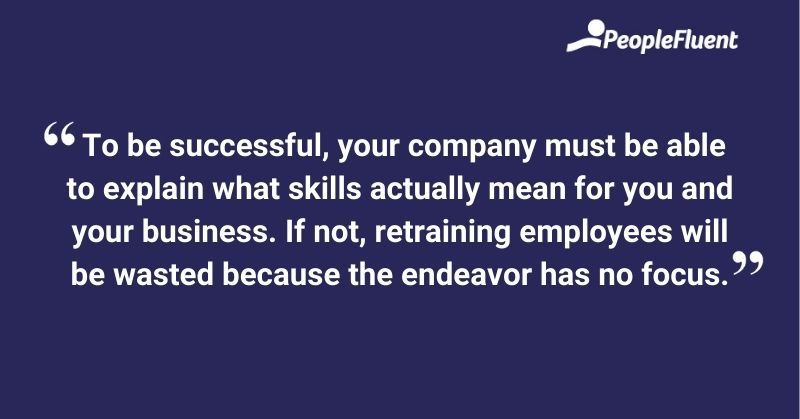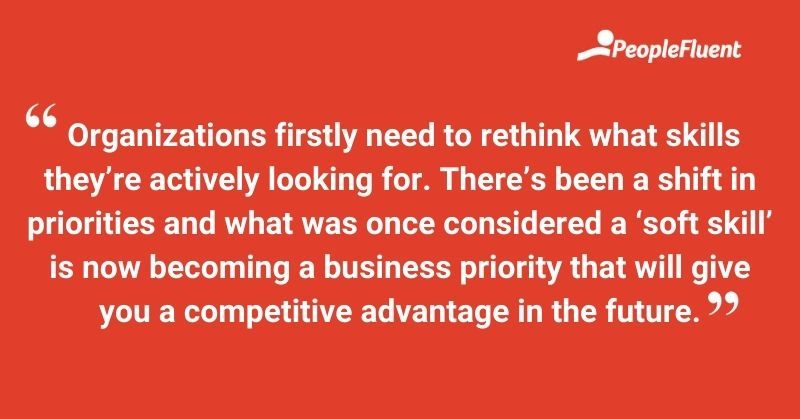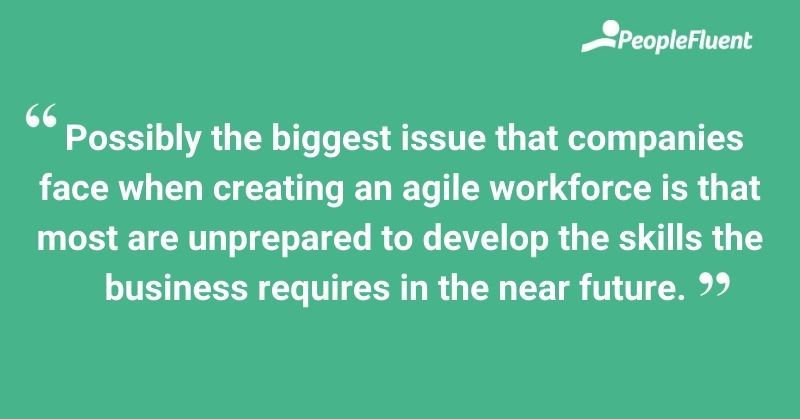Ask most business and HR leaders what they’re most worried about and the topic of widening skills gaps is sure to come up. It’s a huge challenge—one that’s only growing in scope. But there is light at the end of the tunnel. In this blog post, we explore the importance of defining skills, their changing nature, and the skills currently most in demand in the workplace.
In the changing world of work, most employers lack the internal talent mobility to address the widening skills gap. But here’s the thing: this isn’t an issue that organizations can simply hire their way out of!
The solution lies in their learning and development strategies: it’s up to companies to understand what skills are in demand, ensure their employees are trained to deal with the challenges ahead, and create opportunities for internal mobility to give employees the opportunity to properly utilize these skills.
MORE FROM THE BLOG | ‘What Is Talent Mobility? Plus, What It’s Not!’
The Importance of Defining Skills in the Workplace
As organizations rush to uncover their skills gaps, to reskill and upskill their workers for the future, it’s becoming clear that just defining a skill alone isn’t enough. To be successful, your company must be able to explain what skills actually mean for you and your business. If not, retraining employees will be wasted because the endeavor has no focus.
Once your organization understands what skills are and what they mean, here’s what can happen next:
- Learning and development can assign value to skills and communicate better with HR to determine the value of internal human capital.
- Employees and employers can have a conversation about the skills required for a job and identify gaps and developmental opportunities.
- L&D can close those gaps with content that teaches those skills.
- HR can recruit for those skills and reward for skills learned.
- Employees can know where they stand in terms of being viewed as high-potential based on their skills.

KEEP READING | ‘Upskilling vs. Reskilling: Understanding the Differences and Their Role in Talent Mobility’
What Are the Most In-Demand Workplace Skills?
According to Brandon Hall Group’s ‘2021 Competency and Skills Development Study’, these are the top 10 skills companies are looking to develop to ensure their success in the future:
- Emotional intelligence
- Critical thinking
- Innovation
- Analytics
- Collaboration
- Continuous learning
- Adaptability
- Coaching mindset
- Learning agility
- Valuing diversity
Organizations firstly need to rethink what skills they’re actively looking for. There’s been a shift in priorities and what was once considered a ‘soft skill’ is now becoming a business priority that will give you a competitive advantage in the future.
How to Maximize Learning and Development Within the Workforce
These skills are what will enable your organization to maximize internal mobility and upskill for the future. Workers who can utilize these skills are more likely to be able to adapt to the changing current of work, regardless of what technical abilities might be required.
As the global economy becomes more uncertain and change comes in bigger and more frequent waves, workforce agility is more important than ever.

YOU MIGHT ALSO LIKE | ‘Rise of the Modern Talent Journey: Mapping the New Employee Experience’
How to Leverage Talent and Internal Mobility
The top two elements in organizations’ vision for talent management are:
- Leverage our talent to be a sustainable competitive advantage for the organization.
- Increase workforce agility that leverages diverse skills, competencies, and experiences to meet continually evolving business needs.
Unfortunately, companies continue to face a series of obstacles in the pursuit of these goals.
What Challenges Do Organizations Face in Developing and Managing Competencies and Skills?
According to the 2021 Brandon Hall Group Competency and Skills Development Study, these are the top skills development challenges faced by businesses:
- 61% of managers aren’t offering their employees enough feedback and coaching.
- 48% of executives aren’t aligned on how to develop competencies and skills across the organization.
- 47% believe they don’t have a long-range plan for identifying what type of talent pool we need for the future and the associated competencies and skills.
- 46% believe they don’t have Individual Development Plans (IDPs) for every employee.
- 45% don’t have the right technology to assess and track the development of their workforce.
- 44% state that their HR team doesn’t have enough of the right people to support an enterprise-wide competency and skills development program at the depth and breadth needed.
- 43% have limited resources to provide the necessary learning to develop the workforce.
- 40% of managers aren’t aligned with their employees’ IDPs.
- 38% don’t incentivize their employees to develop.
- 36% think there’s an issue with the number of roles in the organization.
How Can Skills Development Challenges Impact a Business?
Possibly the biggest issue that companies face when creating an agile workforce is that most are unprepared to develop the skills the business requires in the near future.
Take a look at these percentages of employers who believe the following statements:
- Employee engagement isn’t where it needs to be: 59%
- We could react faster to the market and business condition: 54%
- Holding onto our best employees is challenging: 54%
- Creativity and innovation from our workforce are stifled: 47%
- Our talent costs are higher because our people aren’t at their full capability: 43%
- Our leadership isn’t prepared to handle the current and future needs of the business: 38%
- Profitability growth could be greater and happen faster: 33%
- Revenue growth could be greater and happen faster: 28%
- We have more missteps and mistakes happen: 24%
It isn’t just about being prepared for the future. Companies need to be aware of the skills most in demand in the post-pandemic workplace and adequately equip their employees. The top learning priority for this period is training in the skills that are needed right now.

HANDPICKED FOR YOU | ‘5 Strategies to Improve Talent Mobility’
The Importance of Learning in the Post-Pandemic Workplace
Looking at the research, it’s clear that the development of critical skills is vital to get companies through this difficult and uncertain future.
Brandon Hall Group’s report, ‘Transitioning to the New Realities of the COVID-19 Experience’, found that 71% of employers were focusing on training in skills needed now, 69% on the development of existing leaders, and 67% on coaching and mentoring. There’s been a huge shift from businesses to train and upskill their existing employees to prepare them for the new challenges ahead.
Here are the top 12 soft skills employers believe will be important to develop in their current workforce:
- Emotional intelligence
- Leadership specific to teams
- Longer-term competency and skills development
- High-potential leader development
- Team development
- Diversity and inclusion
- Coping skills
- Technical skills
- Performance management training
- Unconscious bias awareness
- Compliance training
- Sales training
How to Make Learning a Business Priority
In order to build a mindset that focuses on internal mobility, you should focus on some of the following:
- Uncover the skills your people have but aren’t leveraged because the skills were hidden or unknown.
- Determine skills that can be rapidly acquired based on existing skills, capabilities, behaviors, and aspirations.
- Find opportunities to explore capabilities that emerge as skills and are combined in new ways.



